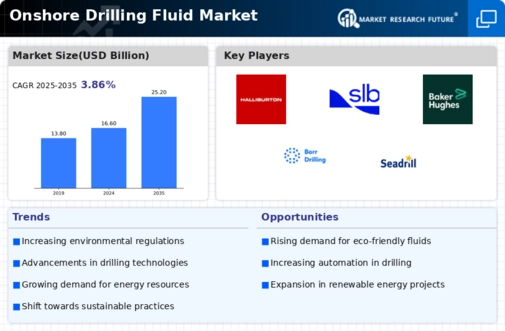Rising Oil and Gas Prices
The Onshore Drilling Fluid Market is closely tied to fluctuations in oil and gas prices. As prices rise, exploration and production activities tend to increase, leading to a higher demand for drilling fluids. In 2025, the market is likely to benefit from a rebound in oil prices, which could stimulate investments in new drilling projects. This resurgence is expected to create a favorable environment for the Onshore Drilling Fluid Market, as operators seek to maximize output and efficiency. Consequently, the demand for innovative and effective drilling fluids is projected to grow, aligning with the overall recovery of the energy sector.
Increasing Exploration Activities
The Onshore Drilling Fluid Market is experiencing a surge in exploration activities, particularly in regions rich in untapped resources. This trend is driven by the need for energy security and the desire to reduce dependency on imports. As countries seek to enhance their domestic production capabilities, the demand for effective drilling fluids becomes paramount. In 2025, the market is projected to witness a growth rate of approximately 5.2%, reflecting the increasing investments in exploration and production. Enhanced drilling techniques necessitate the use of advanced fluids that can withstand challenging geological conditions, thereby propelling the Onshore Drilling Fluid Market forward.
Growing Demand for Shale Gas and Oil
The Onshore Drilling Fluid Market is witnessing a notable increase in demand for shale gas and oil, driven by the need for alternative energy sources. As countries aim to diversify their energy portfolios, the exploration of shale reserves has become a focal point. This trend is expected to continue, with shale production projected to account for a significant portion of total oil and gas output by 2025. The unique challenges associated with drilling in shale formations necessitate the use of specialized drilling fluids that can enhance recovery rates and reduce operational costs. Thus, the Onshore Drilling Fluid Market is poised for growth as it adapts to these evolving demands.
Regulatory Compliance and Environmental Standards
The Onshore Drilling Fluid Market is significantly influenced by stringent regulatory frameworks aimed at minimizing environmental impact. Governments are implementing more rigorous standards for drilling operations, which necessitates the use of environmentally friendly drilling fluids. This shift is not merely a trend but a requirement for compliance, as companies face penalties for non-adherence. The market is adapting by developing innovative fluid formulations that meet these regulations while maintaining performance. As of 2025, the demand for eco-friendly drilling fluids is expected to rise, potentially accounting for over 30% of the total market share, thus reshaping the Onshore Drilling Fluid Market.
Technological Advancements in Drilling Techniques
The Onshore Drilling Fluid Market is being transformed by rapid technological advancements in drilling techniques. Innovations such as horizontal drilling and hydraulic fracturing have revolutionized the way resources are extracted. These methods require specialized drilling fluids that can enhance performance and efficiency. The integration of real-time data analytics and automation in drilling operations is also influencing fluid selection, as operators seek to optimize their processes. By 2025, it is anticipated that the adoption of these advanced techniques will lead to a 7% increase in the demand for high-performance drilling fluids, thereby driving growth in the Onshore Drilling Fluid Market.

















Leave a Comment